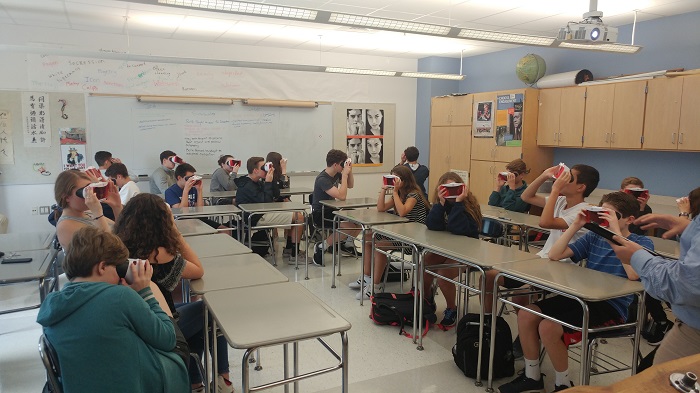Samantha Bookston, Technology Integration Specialist at Needham High School, was awarded a grant of $4,700 in the Fall of 2016 for virtual reality teaching equipment. Here she tells us how this new technology has been used in classrooms to enhance learning across disciplines.
Many of us are new to VR. How exactly does it work?
Virtual reality is a computer-created scenario that mimics a real experience. Last year, the NEF awarded the high school a grant for a virtual reality cart, which includes 30 plastic (cleanable!) viewers, 13 cell phone devices, 1 teacher tablet, 1 router, 1 360 degree camera, and a cart. This allows teachers to easily use the cart for a classroom of students.
Can you tell us about projects this equipment has been used for?
The cart has been widely used across multiple departments, with most teachers using the cart for Google Expeditions. During this type of lesson, a teacher will use the tablet to lead students on an experience related to what they are currently studying. For example, a psychology class is able to go on an expedition that explores different parts of the brain–where they are located within relation to one another, and what they look like up close as the brain is working. A social studies class went on an expedition to the trenches of World War I and were able to put themselves in the trench and look around, making observations on what it would have been like in this small area for a length of time. In this particular expedition, they were able to hear warfare sounds as well. Expeditions is a free app that comes with about 8 panoramic slides per expedition; on each of these slides is a 360 image (some include pictures and audio), text to give context to the image, and key things to point out.
How is VR equipment better than, say, a tablet or Chromebook?
While students can use tablets, Chromebooks, or other online resources for making connections, the VR cart allows the students to experience and make their own observations because they are placed within the picture or video. The first time a classroom puts on the goggles, there are typically a lot of wows, oohs and aahs!
How have the students and teachers reacted to VR?
Teachers are really excited about the VR cart. It has been set up to be easily integrated in the classroom as an enhancement. Some teachers have gone a little farther and have done projects where the students create the virtual reality experience themselves. The students used the 360 camera to shoot a scenario for wellness class, and then they edited it to use as a teaching video for their classmates. A world language class studied different French-speaking countries and edited 360 images together with their voices to create cultural videos. They then used these videos to learn about different cities.
As virtual reality is becoming more popular, we are excited to expose our students to it. They are making connections using multiple senses and are learning how this new technology and kind of experience can make an impact.

